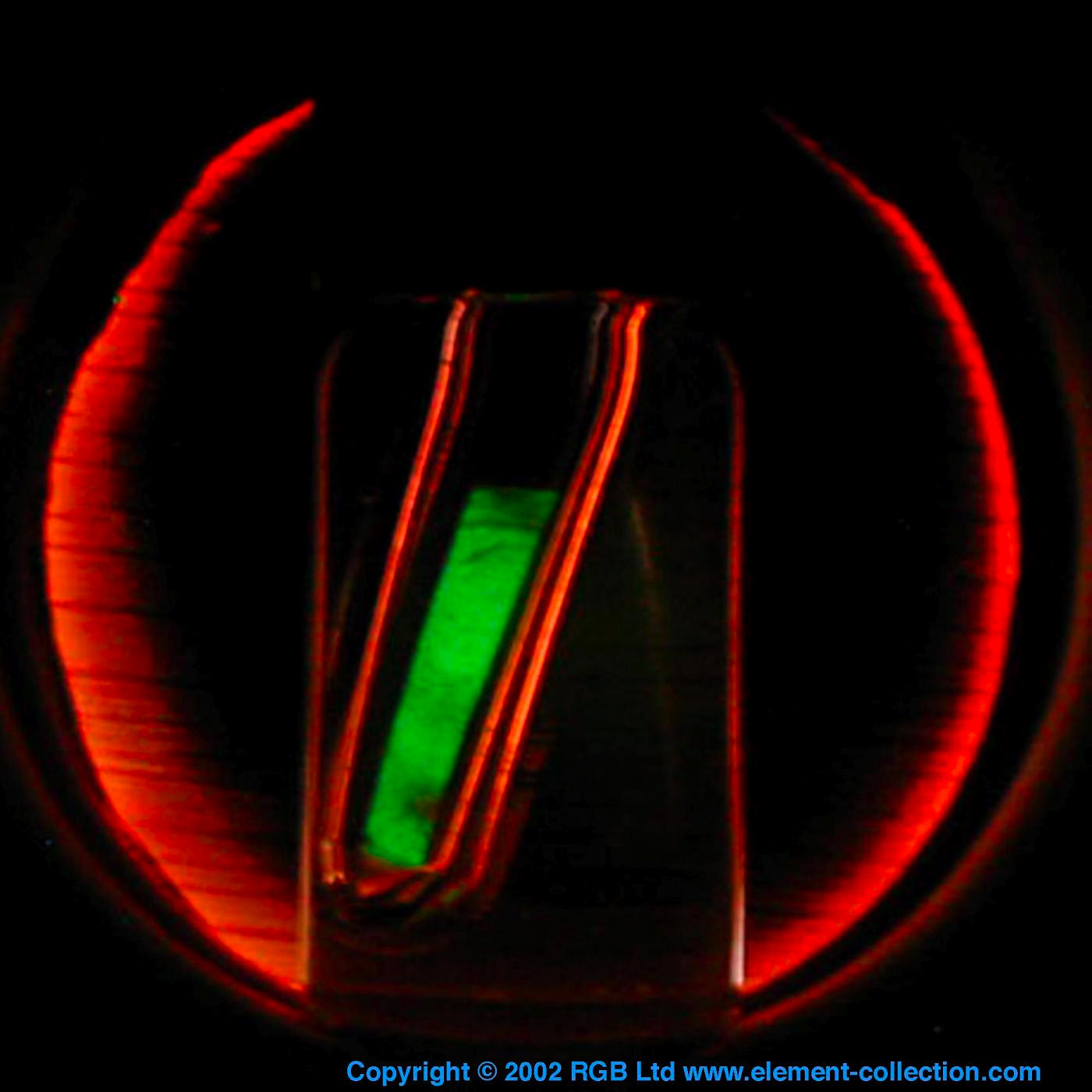|
|
|
|
|
|
|
|
|
|
|
|
|
|
|
Promethium is one of those elements I really never expected to get. It seems so exotic. But it turns out that there was a brief period of time after radium was judged too dangerous for common use in luminous products and before tritium because available, when promethium was used in to make luminous markings. It was used on such products as the thermostats of electric blankets, of all things.
But it was only used for a short time before being replaced by tritium, which is far safer than either radium or promethium. I have not yet located any actual products using promethium.
Promethium is an anomaly in that it is one of only two elements with atomic number less than 84 that have no stable isotopes. Elements 84 and higher all have no stable isotopes.
|
|
| |
|
|
|
|
|
|
|
|
Sample from the RGB Set.
The Red Green and Blue company in England sells a very nice element collection in several versions. Max Whitby, the director of the company, very kindly donated a complete set to the periodic table table.
To learn more about the set you can visit my page about element collecting for a general description or the company's website which includes many photographs and pricing details. I have two photographs of each sample from the set: One taken by me and one from the company. You can see photographs of all the samples displayed in a periodic table format: my pictures or their pictures. Or you can see both side-by-side with bigger pictures in numerical order.
The picture on the left was taken by me. Here is the company's version (there is some variation between sets, so the pictures sometimes show different variations of the samples):

Source: Max Whitby of RGB
Contributor: Max Whitby of RGB
Acquired: 25 January, 2003
Text Updated: 11 August, 2007
Price: Donated
Size: 0.2"
Purity: 99.5%
|
|
|
|
|
|
|
Sample from the Everest Set.
Up until the early 1990's a company in Russia sold a periodic table collection with element samples. At some point their American distributor sold off the remaining stock to a man who is now selling them on eBay. The samples (except gases) weigh about 0.25 grams each, and the whole set comes in a very nice wooden box with a printed periodic table in the lid.
Radioactive elements like this one are represented in this particular set by a non-radioactive dummy powder, which doesn't look anything like the real element.
To learn more about the set you can visit my page about element collecting for a general description and information about how to buy one, or you can see photographs of all the samples from the set displayed on my website in a periodic table layout or with bigger pictures in numerical order.
Source: Rob Accurso
Contributor: Rob Accurso
Acquired: 7 February, 2003
Text Updated: 29 January, 2009
Price: Donated
Size: 0.2"
Purity: 0%
|
|
|
|
|
|
|
  Fluorescent bulb initiator. Fluorescent bulb initiator.
I think the two wires on either side of the coil in this picture are coated with a tiny amount of promethium-147. This is one of the electrodes from the inside of a Philips compact fluorescent bulb which my research indicates contains the substance as an arc initiator. Arguing against the proposition is that even my very sensitive mica-window Geiger counter does not detect any radioactivity. That, however, could be because only a very small amount is required for the thing to do its job, and I may not be able to detect it above the background level
Source: bulbconnection.com
Contributor: Theodore Gray
Acquired: 8 March, 2008
Text Updated: 8 March, 2008
Price: $5
Size: 0.5"
Purity: 0%
|
|
|
|
|
|
|
  Promethium luminous compass. Promethium luminous compass.
This is a beautiful solid brass compass of a design that dates back to WWI, but this one was most likely made in the 1950s or 1960s, assuming it does in fact, as claimed, contain promethium luminous paint on the dial. I hope it does because otherwise I don't have any example of a promethium luminous object.
Source: eBay seller ebms2006
Contributor: Theodore Gray
Acquired: 28 February, 2009
Text Updated: 1 March, 2009
Price: $60
Size: 2.5"
Purity: 0%
|
|
|
|
|
|
|
  Promethium igniter. Promethium igniter.
The box for these compact fluorescent bulbs says they contain Pm-147 glow switches, which means a tiny amount of radioactive substance designed to keep the gas inside just ionized enough that the lamp will light when it's turned on.
Source: Unknown
Contributor: Theodore Gray
Acquired: 17 April, 2009
Text Updated: 30 April, 2009
Price: Unknown
Size: 6"
Purity: <0.01%
|
|
|
|
|
|
|
Promethium glow switch.
I'm still trying to figure out exactly which part of the compact fluorescent bulbs I have contain the actual promethium. This might be it.
Source: Unknown
Contributor: Theodore Gray
Acquired: 29 April, 2009
Text Updated: 30 April, 2009
Price: Unknown
Size: 1"
Purity: <0.01%
|
|
|
|
|
|
|
|
|
|
|
|